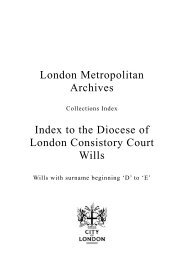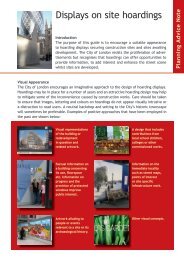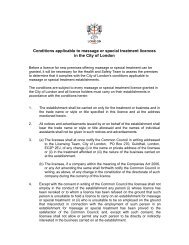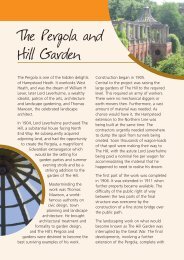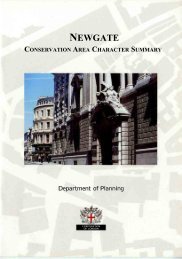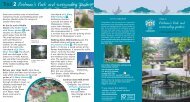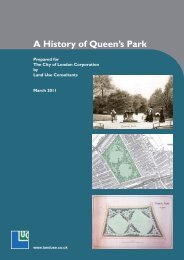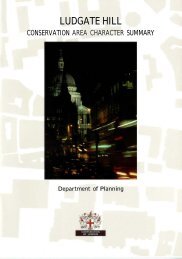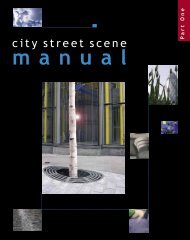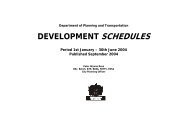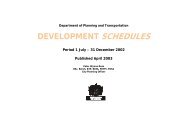Burnham Beeches Management Plan 2010 - the City of London ...
Burnham Beeches Management Plan 2010 - the City of London ...
Burnham Beeches Management Plan 2010 - the City of London ...
Create successful ePaper yourself
Turn your PDF publications into a flip-book with our unique Google optimized e-Paper software.
2.2 Importance <strong>of</strong> grazing<br />
Grazing is seen by <strong>the</strong> <strong>City</strong> <strong>of</strong> <strong>London</strong> and<br />
Natural England to be <strong>the</strong> critical project to<br />
ensure <strong>the</strong> long term, sustainable management<br />
<strong>of</strong> <strong>Burnham</strong> <strong>Beeches</strong> as an SSSI and SAC. The<br />
vision to expand conservation grazing across<br />
<strong>Burnham</strong> <strong>Beeches</strong> is fully supported by Natural<br />
England and is seen as <strong>the</strong> ideal method by<br />
which to ensure <strong>the</strong> reserve’s long term viability<br />
as a Site <strong>of</strong> Special Scientific Interest.<br />
The habitats for which <strong>Burnham</strong> <strong>Beeches</strong> is<br />
famous - wood pasture and heathland/mire -<br />
were all once grazed by domestic livestock.<br />
There has been a long history <strong>of</strong> livestock grazing<br />
across <strong>the</strong> area, which can be deduced from <strong>the</strong><br />
age <strong>of</strong> <strong>the</strong> pollards (which must have been<br />
developed in a grazed system), <strong>the</strong> presence <strong>of</strong><br />
<strong>the</strong> pound, historical records <strong>of</strong> species found<br />
and writings and pictures describing <strong>the</strong> <strong>Beeches</strong><br />
in <strong>the</strong> past.<br />
If grazing was a fundamental force, shaping <strong>the</strong><br />
<strong>Beeches</strong> for centuries, <strong>the</strong>n <strong>the</strong> last 60 years<br />
without grazing created many <strong>of</strong> <strong>the</strong> problems <strong>of</strong><br />
loss <strong>of</strong> habitat and diversity that we face today.<br />
However, <strong>the</strong> reintroduction and subsequent<br />
expansion <strong>of</strong> <strong>the</strong> grazing since 1992 has already<br />
reaped benefits.<br />
In <strong>the</strong> areas that are now grazed <strong>the</strong>re are plants<br />
not seen for over 80 years, grown from seed left<br />
in <strong>the</strong> soil now that grazing animals have created<br />
<strong>the</strong> open, light conditions and varied ground<br />
surface <strong>the</strong>y needed to grow and thrive. The<br />
growth <strong>of</strong> ‘weedy’ woodland trees like birch is<br />
kept in check and a diverse mosaic <strong>of</strong> plant<br />
species and structures are created benefitting<br />
many invertebrates. Tree regeneration is not<br />
completely stopped however: shrubs and<br />
dead wood protect some<br />
seedlings that are able to grow<br />
into mature oak and beech trees.<br />
2 <strong>the</strong> need for <strong>Management</strong> - grazing<br />
Species such as juniper grow and regenerate<br />
better in <strong>the</strong>se environments, as can already<br />
been seen on <strong>the</strong> heath, and <strong>the</strong>re is a whole<br />
new habitat for <strong>the</strong> specialist plants and animals<br />
that rely on herbivore dung.<br />
Grazing is undoubtedly <strong>the</strong> best management<br />
option for <strong>the</strong>se areas because it creates a more<br />
varied structure <strong>of</strong> vegetation than mechanical<br />
methods <strong>of</strong> management, such as mowing. It is<br />
also more sustainable: cheaper in <strong>the</strong> long run,<br />
and less polluting.<br />
Expanding <strong>the</strong> grazing across <strong>Burnham</strong> <strong>Beeches</strong><br />
presents significant challenges, especially in<br />
relation to traffic management and poorly<br />
controlled dogs. However, <strong>the</strong>re are clear<br />
benefits to visitors as <strong>the</strong> livestock open up <strong>the</strong><br />
landscape enabling better views and improving<br />
access, while <strong>the</strong> animals are an attraction in<br />
<strong>the</strong>mselves.<br />
19



